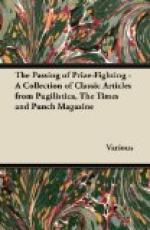Then why this knightly precaution?
* * * * *
A Coup for “The daily Trail.”
We all knew at the office that Micklebrown had gone to Cocklesea for his holiday. If anyone had offered him a free pass to the Italian lakes or any other delectable spot Micklebrown would have declined it and taken his third return to Cocklesea. Like Sir Walter Raleigh when he started for South America to find a gold-mine, Micklebrown had an object in view. He hoped to discover a topaz in Cocklesea. We knew the reason for this optimism. We had been shown the lizard-brooch, a dazzling thing of gold and precious stones, which Micklebrown had picked up last Bank Holiday on the cliff at Cocklesea and presented to his fiancee, Miss Twitter, after inquiry at the police-station had failed to discover its owner.
Most people would have been satisfied to leave well alone, but Micklebrown is a man who hankers after the little more. The lizard’s tail was composed of topaz stones, and from its tip one topaz was obviously missing. “My firm impression is that I did the damage when I trod on it,” Micklebrown said. “You see I put my foot right slap on the thing. I can’t get it out of my head that that topaz stuck in the mud and it’s sticking there to this day. Anyway I go to Cocklesea for my holiday to look. I know the very identical spot.” He closed his eyes the better to visualize it. “You go up a little path behind the mixed-bathing boxes, turn sharp to the right at the top of the cliff, past two pine-trees and a clump of gorse, go a trifle inland through a lot of thistles until you come on three blackberry bushes; the topaz should be ten inches south-west of the middle one.”
“The colour’ll be a bit washed out, won’t it?” young Lister said; “we’ve had a lot of rain since Bank Holiday.”
Micklebrown’s lip curled but he said nothing. Only to us, his intimates, did he confide that he had no expectation of finding the topaz on the surface; he expected to search through several strata of mud, and he was taking a magnifying-glass and a gravy-strainer with him.
We heard nothing further until I had a postcard from him saying that the rain had caused the blackberries so to multiply that he found it impossible to identify the particular bush near which he had stepped on the lizard; he was therefore making a general search over the area. After that we followed the tale in The Daily Trail:—
SEASIDE VISITOR’S STRANGE CONDUCT.
Much curiosity has been aroused at Cocklesea by the behaviour of a visitor who spends his days on the cliff burrowing in the earth in all weathers. Speculation is rife as to the object of his occupation. It is generally concluded that he is the victim of shell-shock.
ROMANTIC DISCLOSURE BY COCKLESEA CLIFF BURROWER.




